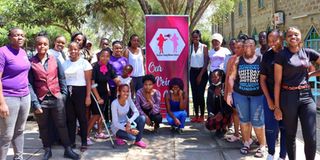Young girls form bulk of new HIV infections

Members of Positive Young Women Voices pose for a photo after a charity session. A new study shows that majority of new HIV infections are among young women.
What you need to know:
- NACC data shows that a total of 41,728 new cases were recorded this year, 25,062 of them being female and 16,666 male.
- Currently, there are 1.5 Kenyans living with HIV, with statistics showing that 942,653 are women and 565,752 men.
- Nascop also indicates, in the report, that more than 41,000 new infections were registered in 2019, translating to 114 people being infected every day and five people every hour.
Young girls form the bulk of new HIV infections in the country according to the latest report by the National Aids Control Council (NACC).
NACC data shows that a total of 41,728 new cases were recorded this year, 25,062 of them being female and 16,666 male.
Those aged 15 years and above recorded 34,610 new infections, with 6,806 cases documented among children aged 14 years or below.
The national prevalence is 4.5 per cent, which is a slight reduction from the 4.7 per cent recorded last year.
Women still bear the biggest HIV burden with 5.8 per cent in the age bracket of 19 and 29 years testing positive compared to 3.1 per cent among their male counterparts.
1.5 million infections
Currently, there are 1.5 Kenyans living with HIV, with statistics showing that 942,653 are women and 565,752 men.
Statistics from the National Aids and STI Control Program (Nascop) show that infections in the country currently stand at 1.5 million with 942,653 being women and 565,752 men.
Nascop also indicates, in the report, that more than 41,000 new infections were registered in 2019, translating to 114 people being infected every day and five people every hour.
The organisation says 20,997 people lose their lives in Kenya every year due to HIV/Aids, translating to 404 Aids deaths per week and about 58 in a day. The new infections have been attributed to unsafe sexual practice.
Head of Nascop Dr Catherine Ngugi, says there are more than 288 HIV infections among adolescent girls and young women every week in Kenya.
World Aids Day
"Besides this, our eight per cent Mother-to-Child Transmission (MTCT) rate translates to an annual 4,800 new infants joining the People Living with HIV/Aids (PLHIV) communities, which is intolerable,” says Dr Ngugi in the report.
She, however, noted that this year's World Aids Day came at the backdrop of several strides the agency had made, among them a 57 per cent reduction in Aids -related death (2012 to 2020), a PMTCT coverage of 94 per cent and a 47 per cent decline in HIV-related deaths.
The counties of Homa Bay, Siaya, Kisumu, Migori, Kiambu, Kajiado, Mombasa, Kisii, Nairobi, Nakuru, Uasin Gishu and Kakamega registered an increase of 1,000 infections in 2019.
The report further shows more than 20,000 deaths were recorded in 2019 alone. Young people (10 to 24 years) and adolescents (10 to 19 years), especially young women and young key populations, continue to be disproportionately affected by HIV.





